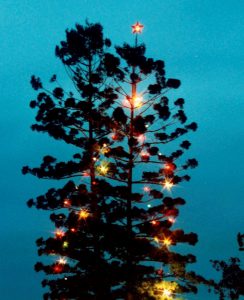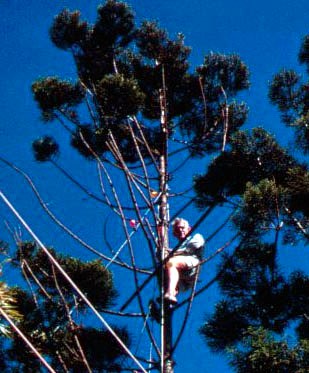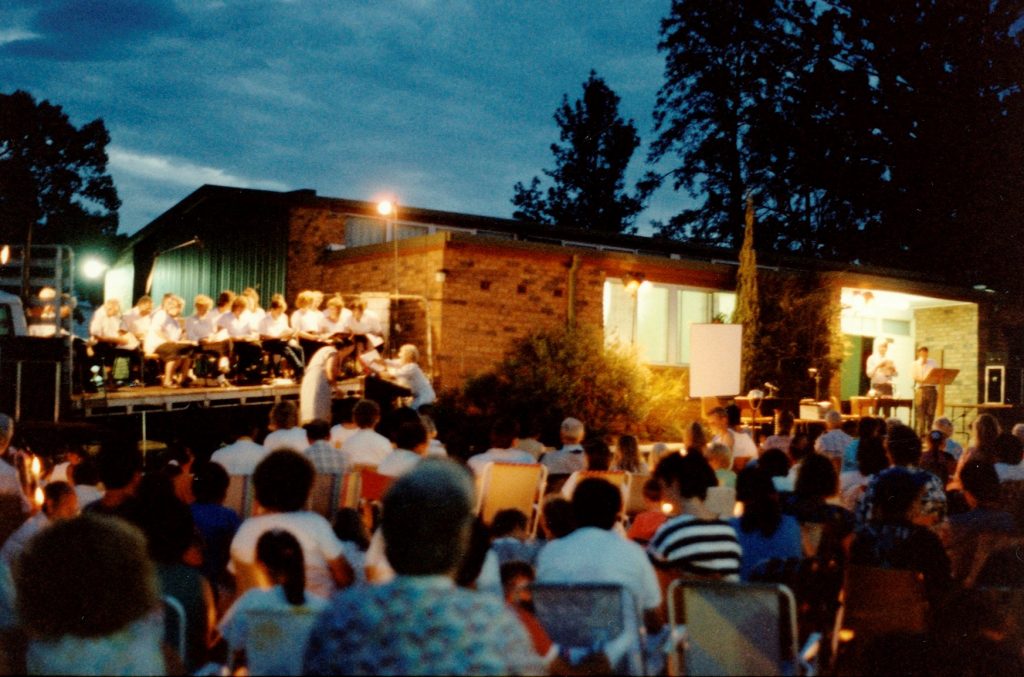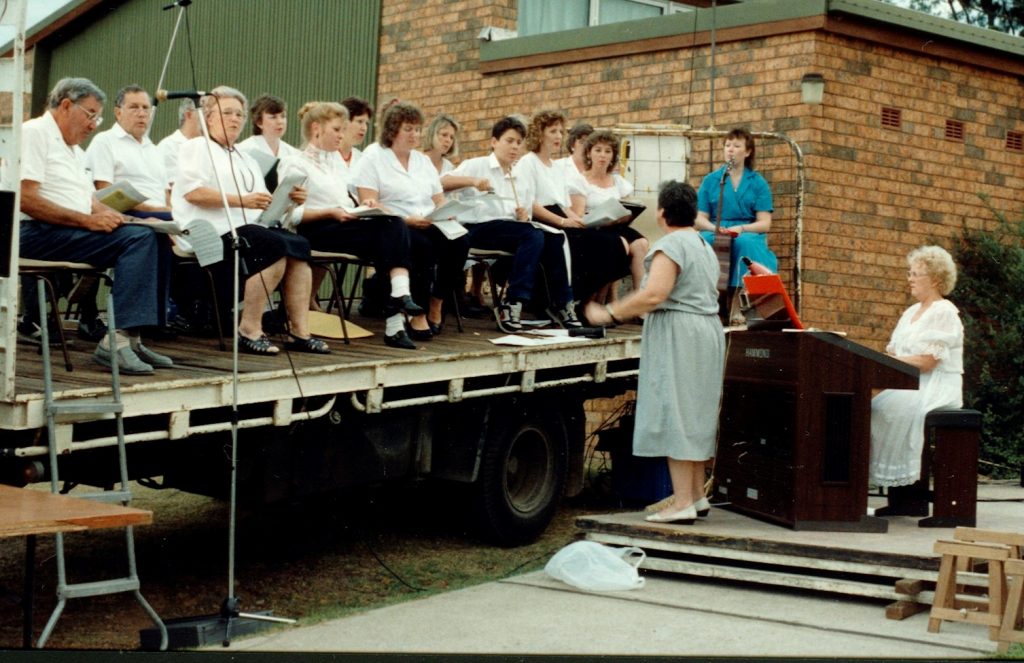by Rosemary Phillis and Jim Ferguson

In the Christmas season many locals decorate their homes and gardens with festive Christmas lights. This tradition did not start en-masse` until the late 1990s.
St Andrews Uniting Church at Riverstone was decades ahead of everybody else, as every year from around 1954 until 2000 they decorated a pine tree in the church grounds with coloured lights and an illuminated star.
The tree and lights were a popular local landmark in the Christmas season, many people drove through the town just to see them.
The Church ‘lights’ tradition started around 1954 when the church was known as the Presbyterian Church. The first star was built by Fred Coulter, a local shopkeeper. The star was made of Masonite and had a small 25W pilot globe on each point.
Jim Ferguson recalls that he was part of the original team which started the tradition in 1954: “As well as the star, we had two strings of lights, hired from Prospect Electricity, to run up each side of the tree, up one side and down the other (4 runs).
We always needed a crew of at least six to put up the lights in position. No one person can claim to be responsible for placing the lights in the tree. Fred Coulter certainly put the thought of many into practice when he made the first star and I was fortunate enough to be the first person to bring the dream to fruition, by climbing the tree to put up the star, but it could not have been done without the support of the team, members of the church and encouragement from members of the community.
Others who climbed to the top included Garth Gee, my brother Barry Ferguson, John Hunt, Mark and Ron Newsome, others who made the journey part way up included Howard Voysey, Ern Nichols, Wal Shoobridge and Geoff Ham.
I am sure that there were others but I regret that time has eroded my memory. Our ground crew consisted of at least four persons, including Roy Turnbull, the Ministers of the day, Mike Strong, Geoff King and some of our younger people.

Photo courtesy of Jim Ferguson
Originally we had no safety equipment, climbing was hand over hand and once we had reached the required height, we pulled the star and the equipment up manually.
We designed and constructed a new star. It was cut out of a single sheet of aluminium and covered in reflective tape. Jerry Carson arranged sufficient red adhesive sheeting, to cover the whole star. Illumination was via two 60W globes, one each side of the star. Each globe was covered in a hood which had holes and slots strategically punched in it to allow the light to beam to each point of the star. From a distance this gave the star a 3D effect.
Rather than continuing to hire lights which were being phased out by Council, we were able to make our own, thanks to the generosity of Roy Turnbull, Barry Ferguson and others, using full sized coloured party globes. The use of a pulley made it easier to raise and lower the star and the lights.
Safety improvements came in the form of rope belts supplied by electricians Howard Voysey and later John Hunt. The tree climbing was carried out in the early morning, as early as 6 o’clock in the morning or late in the evening around 6 pm.
At some stage our church started holding a Carols by Candlelight service in the church grounds. We always aimed to have the lights up in the tree the Saturday before the carols.
Towards the end of the 1990s it was becoming difficult to find someone willing to climb the tree. The tree was getting older and had some dead timber in it, making it a difficult and potentially dangerous task. There were also issues around running full voltage lights up through the trees.
Vandalism caused us some concern, we lost a few globes every year, however toward the end of the century our display was almost ruined with the theft of over thirty globes from the lower levels and breakages caused by people catapulting small staples at the globes.
To the disappointment of many, in 2001 we did not put the lights up in the tree. Instead we mounted a display on the end of the church building with the theme ‘Jesus is the Reason for the Season’. For the next few years we arranged different displays, but these were too ambitious for our light-weight equipment and a severe southerly blow brought the top to ground level. A considerable amount of work was put into installing the cross in its present position, however a tree branch is in the way, which prevents it being raised and lowered without difficulty and damage. There was no display in 2007, but I am advised that every effort will be made to have a display in 2008.
Although the church no longer displays lights in the tree, others around the town carry on the tradition. I have a unique souvenir of our efforts; a sand cricket inside a clear electric light globe, which was at the top of the display in the star, almost 80 feet above ground level!”

Christmas Carols and Carols by Candlelight
In the late 1940s, the Young People’s Fellowship of the Presbyterian Church started a tradition of singing Christmas Carols around the town. They used Norm Powe’s truck, loaded a full sized church pump organ onto the back, tied on some church stools and egg crates to sit on, then drove around town, with Joyce Nichols playing the pump organ and the others singing Christmas Carols.
The church started a ‘Carols by Candlelight’ service in the grounds of the church. I can recall attending these events in the 1960s. Adults sat on chairs, children generally sat on mats that had been rolled out on the grass. The choir was on a raised stage situated in front of the wooden church building. Music was provided by Mrs Nichols playing the organ.
Candles were supplied, sometimes with cardboard to protect your hand from the wax and at one stage small pieces of plywood. There was the inevitable singed hair, but fortunately no major burn injuries, apart from the occasional wax spot burns.
The carols service became ecumenical, with the other churches in the town taking their turn to organise the event, always held in the Presbyterian/Uniting church grounds. Various religious sketches were often enacted during the carol services with the participation of the local schools.
On one occasion rain threatened the activity so it was transferred into the hall. One of the plays included the use of a live donkey. We were assured that the animal had been stage trained, so we continued with the play. Much to the consternation of the gathering the silly ass forgot himself, resulting in a quick evacuation of the hall and the subsequent replacement of the stage carpet.
As more and more people attended and Garfield Road became busier and much noisier, it was decided to move the event. After three or four years in the Lions Park and one year when it was washed out and held in the Community Church, the event was relocated to the vacant land on the corner of Park and Pitt Streets, where it is still held. The ecumenical theme continues, with all welcome to the event.

Photo courtesy of Rosemary Phillis
